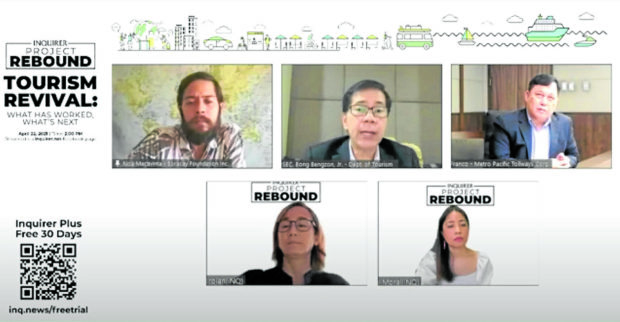It’s not just the sites; for travelers, it’s safety first

The Inquirer Group recently held a webinar entitled “Tourism Revival: What has Worked, What’s Next.”
With people now more conscious about their health and safety, businesses under the travel and hospitality sector, as they continue to bear the brunt of the pandemic’s economic impact, need to focus on the future of Philippine tourism: to become an industry that creates “low-density and high-value” experiences for consumers.
In short, according to the Department of Tourism (DOT), mass tourism may very well be a thing of the past.
This long-term forecast was the highlight of the discussion at the recent webinar “Tourism Revival: What has Worked, What’s Next.” Moderated by the Philippine Daily Inquirer’s Lifestyle Editor Cheche Moral and Visayas Bureau Chief Connie Fernandez-Brojan, the webinar is part of the broadsheet’s Project Rebound, which aims to help the country’s businesses, especially those in the tourism and hospitality sector, as they continue on their road to recovery.
Opportunities
While that road is looking to be a long and arduous one given the recent surge of COVID-19 cases—as Dinibeach Bar manager and Boracay Foundation Inc. board member Noa Macavinta puts it, the situation in Boracay has become “dire” with no guests to fill up rooms—changing consumer behavior presents a number of long-term opportunities for the local travel and tourism industry.
According to Tourism Undersecretary Benito Bengzon Jr., Filipinos now look for more low-density destinations and more personalized tourism offerings, in line with the major concern everyone now has when stepping out of their homes: keeping themselves safe from the virus.
“There should be lasting emphasis on standardizing safety and hygiene protocols,” said Macavinta.
Travel confidence
“What’s important is we restore travelers’ confidence,” added Bengzon. “We don’t need massive infrastructure investments; what’s important is that we make sure facilities are properly maintained in terms of health and safety.”
A survey of over 7,000 Filipinos across 78 provinces in the country affirms just how important it is to standardize such protocols. Results indicate that “varying local government unit safety protocols is the top source of travel inconvenience”; therefore, a unified system would help in easing the difficulty of traveling in today’s pandemic-ridden world.
The same study, conducted in February by the DOT, the Dr. Andrew L. Tan Center for Tourism and online tourism platform Guide to the Philippines, says that because consumers are more cautious about their travel movements, their preferences have evolved and shifted toward outdoor activities, such hiking, biking and going to the beach.
In a statement, Tourism Secretary Bernadette Romulo-Puyat said sustainable and cultural tourism also posed plenty of opportunities to the local travel industry.
In terms of companions, the study also highlights that people will most likely choose to travel with family—again, the people they deem safest to be with.
And because long-distance travel remains quite a hassle for many tourists, road trips will most likely become a popular activity among many Filipinos. Rodrigo Franco, president and CEO of Metro Pacific Tollways, said that expressways had been buzzing with activity because of local tourist movement.
“Filipinos are social creatures. We have been seeing local tourists on our expressways, usually in smaller groups,” he said.
Digital connectivity
Aside from safety, another standard travel offering across all tourism and hospitality establishments should be digital connectivity. In Boracay, for instance, tourism establishments now offer “work from paradise” packages for those who want a change of scenery while still conducting business remotely.
Ultimately, as the local tourism industry moves forward, it also needs to move away from mass tourism in order to grow and survive the global health crisis, said the DOT.
“Low density tourism is the direct opposite of mass tourism,” Bengzon said. “Keep clients to a minimum, but offer bespoke services.” INQ
